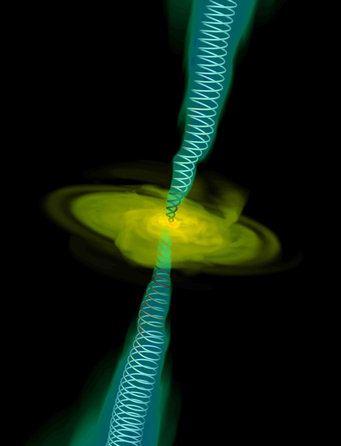In the black holes' pull
Astronomers discover that magnetic fields in the vicinity of supermassive black holes can equal the force of gravity
Black holes dominate their surroundings by their extremely powerful gravitational pull. However, other forces, including magnetic forces, which are usually considered to be weaker, are also at work in the immediate vicinity of these objects. A team of astronomers at the Max Planck Institute for Radio Astronomy in Bonn and the Lawrence Berkeley National Laboratory in the USA has found that magnetic forces can, in fact, be as strong as gravity in the vicinity of black holes.

A computer simulation of gas (yellow) falling in the direction of a central black hole. Towards the top and the bottom, a beam of matter, or jet, strongly focussed by magnetic fields, can be seen with magnetic field lines.
Many black holes that are voraciously consuming matter also expel a fraction of the interstellar gas in two very narrow beams of matter (jets) in opposite directions into space. This is particularly true of supermassive black holes at the centres of active galaxies, where it is possible to detect radio-emissions from such jets.
"We realized that the radio emission from a black hole's jets can be used to measure the magnetic field strength in the immediate vicinity of the black hole itself," says Mohammad Zamaninasab, the lead author of the article published in the scientific journal Nature. He formerly worked at the Max Planck Institute for Radio Astronomy and was a German Research Foundation grant holder. Zamaninasab and his colleagues discovered that the strength of the magnetic fields and gravity in the vicinity of black holes are indeed comparable.
The scientists have simulated this finding on a computer. “When the in-falling gas carries along a magnetic field of sufficient strength in our simulations, then the influence of this magnetic field becomes so strong near the black hole that an equilibrium forms with gravity,” says Alexander Tchekhovskoy from the Lawrence Berkeley National Laboratory. This fundamentally changes the behaviour of the gas near the black hole.
Surprisingly, the magnetic field strength of these exotic objects is comparable to that generated by familiar equipment on Earth: a magnetic resonance imaging scanner, for example; both supermassive black holes and MRI scanners generate magnetic fields that are roughly 10,000 times stronger than the magnetic field of our planet.
The measurements of the magnetic field strength near a black hole were based on a method which involves determining the fraction of the radio emission that is absorbed at different measurement points close to the base of the jet. “Such data already exists for around 100 galaxies from earlier projects for which the Very Long Baseline Array has been used,” says co-author Tuomas Savolainen from the Max Planck Institute for Radio Astronomy. The VLBA is a network of radio telescopes spread across the United States from Hawaii to the Virgin Islands.
According to Savolainen, a large number of these measurements have only recently become available: a comprehensive observing program called MOJAVE systematically monitors several hundred jets originating from supermassive black holes.
Their magnetic field strength has direct effects on the strength of the jets. On the basis of current theories that treat black holes as a kind of spinning magnet, the magnetic field strength also controls the luminosity of the jets at radio wavelengths, i.e. the extremely bright radio jets in the centres of active galaxies emanate in particular from those black holes where the magnetic fields which occur have strengths comparable to that of gravity.
“If our ideas hold up to further scrutiny, then we would have to rethink our assumptions on the properties of black holes and their effect on their environment,” says Eric Clausen-Brown, scientist at the Max Planck Institute in Bonn.”
HOR / NJ
